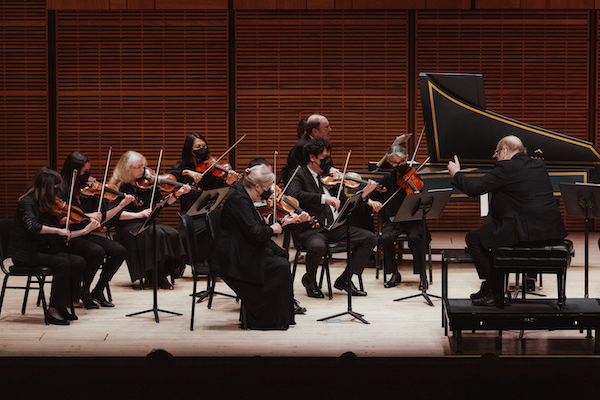Orchestra of St. Luke’s closes Bach festival with fine playing and a lotta yadda

There should be more talk at classical concerts.
More context and listening keys to the music, that is. One of the things that keeps classical music at some remove from the general public is the received wisdom that the tradition comprises endless masterpieces while rarely explaining why that is so. A few details of history and how music works make for more interested, attentive, and curious listeners, and not only for neophytes—a long-time classical music lover is always looking for refreshed ways to hear familiar works.
Start with Bach. The beauty and structural skill and innovation of his work are eternal and profound. And demonstrating why this is so makes Bach even more dazzling as one hears each piece of the puzzle fall into place.
That’s what conductor Bernard Labadie was aiming for Wednesday night as the Orchestra of St. Luke’s finished up a short Bach festival at Zankel Hall with “A Narrated Musical Offering”—a combination lecture and performance on and of Bach’s A Musical Offering. That the talk and music were at times unbalanced is something to learn from, and a reason to do it more and better.
Labadie introduced and a chamber orchestra played A Musical Offering, and much of what he said made the music even more transparent and compelling. The simple device of isolating the fundamental theme and playing it several times cemented that in the listeners’s minds, and made it easy to following and appreciate the ways Bach worked and reworked it into everything from riddles and jokes into the magnificent six-voice figure in the concluding Ricercare.
Hearing this thread also heightened the quality of the performances—one could listen in the same manner as the musicians how the the canons and fugues came together into the ephemeral architecture of musical form and enjoy that in the same manner one imagined the musicians were. It is no triviality to say this is the essence of musical appreciation, of why one comes to a concert hall to hear such a performance and be affected by it.
Labadie did, though, cover a lot of superfluous ground, and at far too great a length.
This was a concert that neared two and a half hours, with a 90 minute first half—both durations too long for a single Bach work. His music is fundamentally succinct and concise, and works best in the concentrated sections he created.
One had to wait for far too long to even hear the opening Riceracare a 3, as the conductor opened the concert not with Bach but an extended introduction to the life of Frederick the Great. This included a performance of the first movement of the king’s Concerto for Flute in C Major. That also introduced one of the most interesting parts of the concert, the appearance of flutist Brandon Patrick George, who Labadie had called just that morning to fill in for the orchestra’s ailing flutist Elizabeth Mann.
The performance of the movement was sunny but seemed, understandably, a little underrehearsed, accurate but not fluid.
That was a minor concern, but the main problem is that the event should have focused on Bach, with Frederick, the instigator of A Musical Offering, as a sidebar, not a central figure.
Regardless, George joined violinist Krista Bennion Feeney and the continuo group of cellist Myron Lutzke and forte pianist Robert Wolinsky for a lovely performance of the Offering’s Sonata Sopr’il Soggetto Reale, which finished the first half.
Labadie’s introductions in the first half were at times stumbling, as if he was in the middle of deciding which ideas to emphasize in what order. He never quite got around simple explanations of fugal techniques like inversion and retrograde, trying to use the printed scores that supplemented the program to make a bridge for those who didn’t read music.
The second half was much better and an example of how this could work. Labadie’s introductions were shorter and quicker, as if he knew he had to pick up the pace.
The energy in all the performances was much sharper and brighter as well. Each canon, even the extended exploration of the puzzle piece canon “in search of an ending,” came as an appetizer for the weight, beauty, and intellectual power of the concluding Ricercare. That climactic performance was extremely fine, each voice given clear yet relaxed articulation, Labadie guiding the shape to a completely satisfying conclusion. Nothing more needed to be said.



